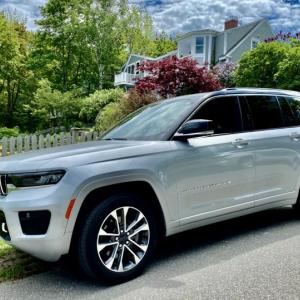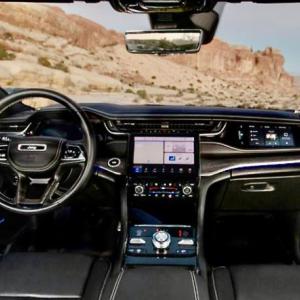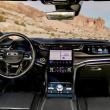Jeep Grand Cherokee Overland 4X4
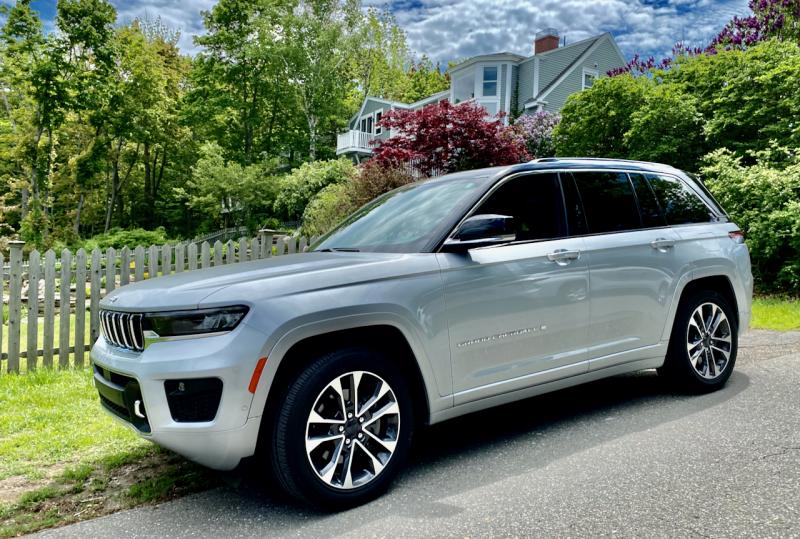 The redesigned Grand Cherokee is longer, wider, taller and more expensive than its predecessor. This color is Silver Zynith over Global Black.
The redesigned Grand Cherokee is longer, wider, taller and more expensive than its predecessor. This color is Silver Zynith over Global Black.
 The Grand Cherokee Overland cockpit. The two tabs flanking the gearshift knob, below the center console, select the drive mode and the ride height. Note the third screen in front of the passenger.
The Grand Cherokee Overland cockpit. The two tabs flanking the gearshift knob, below the center console, select the drive mode and the ride height. Note the third screen in front of the passenger.
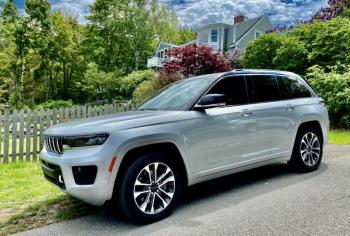 The redesigned Grand Cherokee is longer, wider, taller and more expensive than its predecessor. This color is Silver Zynith over Global Black.
The redesigned Grand Cherokee is longer, wider, taller and more expensive than its predecessor. This color is Silver Zynith over Global Black.
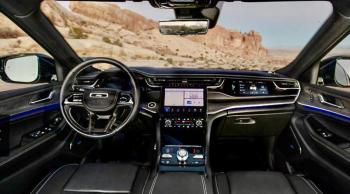 The Grand Cherokee Overland cockpit. The two tabs flanking the gearshift knob, below the center console, select the drive mode and the ride height. Note the third screen in front of the passenger.
The Grand Cherokee Overland cockpit. The two tabs flanking the gearshift knob, below the center console, select the drive mode and the ride height. Note the third screen in front of the passenger.
The top of the Jeep model lineup needs a bit of explication: Once upon a time, there was the full-size Wagoneer, favored by summer residents of big old seaside cottages in New England. Being of truck-type, body-on-frame construction, it begat a Jeep pickup, called the Gladiator, now long extinct. Eventually (after 30 years), the Wagoneer’s perch atop the Jeep lineup was taken over, in 1993, by a more modern, two-row crossover-type SUV called the Grand Cherokee.
Ever since, the Grand Cherokee has reigned supreme—until now. For model-year 2022, the old Wagoneer name was dusted off and again applied to a full-size, body-on-frame vehicle, this time based on the Ram 1500 pickup truck. (Jeep and Ram/Dodge are both Stellantis brands; Stellantis is a new entity that takes in FCA—Fiat Chrysler Automobiles, which owned Jeep—plus Peugeot, Citroen, Opel, Vauxhall and who knows what else.)
But wait, there’s more: Borrowing from its Cherokee line, Jeep also introduced a delux-er version of the new Wagoneer called, yes, the Grand Wagoneer. Both of today’s Wagoneers have three rows of seats, but the Grand one is a foot longer, which makes it about the size of a Chevrolet Suburban. Also, being Grand, it can be optioned up to well north of $100,000. It is commensurately decadent.
Meanwhile, the de-throned Grand Cherokee, evidently feeling the gravitational pull of its new, larger siblings, has been re-designed and enlarged. Last year we drove the extended-wheelbase L model of this new, 5th-generation Grand Cherokee, which also has three rows of seats but is 10 inches shorter than the new Wagoneer and 22 inches shorter than the Grand Wagoneer. Got that?
Today’s subject is the less-lengthy, non-L 2022 Grand Cherokee. It has two rows of seats but lacks nothing else in the way of amenities or options. Style-wise, the new GC has left behind the more chiseled lines of the old Grand Cherokee for the rounder look of the new Wagoneer, but it remains unmistakably Jeep. This is critical, as Jeep depends on its perceived off-road, Granddad-won-the-war cachet to justify high prices.
The stone-axe Wrangler embodies Jeep’s traditional capabilities; the Grand Cherokee is meant to offer nearly the same off-road prowess, but with a heaping helping of comfort and on-road civility on top—an American Range Rover, if you like. Although, since our loaded upper-end Overland 4X4 stickers for $70,360 (base price $55,305), barely half what a roughly similar Range Rover costs, it’s not a true apples-apples comparison.
The priciest extra on our Overland is the 357-horsepower, 5.7-liter V-8 engine, a $3,295 upgrade over the standard 293-horsepower V-6. The bigger motor offers another thousand pounds of towing capacity, to 7,200 pounds, and slightly more zip while dropping the fuel efficiency to a rated 14/22 MPG city/highway. (We averaged about 18 miles per gallon overall.) The V-8 comes only with 4-wheel drive; rear-wheel-drive is an option with 6-cylinder Grand Cherokees. All GCs get an 8-speed automatic transmission.
Jeep offers three drive systems, with varying degrees of off-roadiness: Quadra-Trac I, Quadra-Trac II and Quadra-Drive II, which is standard on the all-conquering GC Trailhawk. Our Overland was configured for more-normal driving: on-road comfort and competence with enough capability to get to that remote mountain cabin. The air suspension, with electronic damping, can raise the Overland for as much as 11.3 inches of ground clearance and the ability to ford 24 inches of water.
Our Overland has the upgraded 10.1-inch touchscreen and a separate screen above the glove box for the front passenger. It also has a 19-speaker, 950-watt McIntosh audio system that’s so good even I can hear the difference.
The Luxury Tech Group IV and Advanced Protech Group III packages are impressive too, with a head-up display, an adjustable 360-degree and off-road camera system (with a washer for the rear lens), night vision with animal and pedestrian detection, rain-sensing wipers, a wireless phone charger, fancy upholstery and trim, heated, ventilated and massaging front seats, a power-adjustable steering wheel, window shades for the back seats and more, plus all the now-normal active driver aids.
My wife never liked the 4th-gen Grand Cherokee. She’s pleased with this one: “it’s comfortable and easy to get in and out of.”
If she could still drive, she might add, “Thanks to a handful of different driving modes, the experience behind the wheel is confident and responsive, and can vary from relaxed—if the job is to just get home after a long day—to aggressive, if an empty, winding mountain road beckons.”
She did pick up on an odd note, a slightly hoarse chuffing sound at idle: the no-longer-familiar sound of a normally aspirated V-8 engine sucking and pumping.
Soon, a plug-in hybrid version of the Grand Cherokee, the 4xe, will arrive. This should help atone for the gas version’s antiquated fuel efficiency. Jeep claims the 4xe can traverse the full length—22 miles—of Moab’s famous Rubicon off-road trail on electricity alone. The priciest Grand Cherokee will be the Summit Reserve 4xe, with a starting price of about $76,000. At the other end of the scale, a basic RWD V-6 Laredo starts at just over $40,000.

